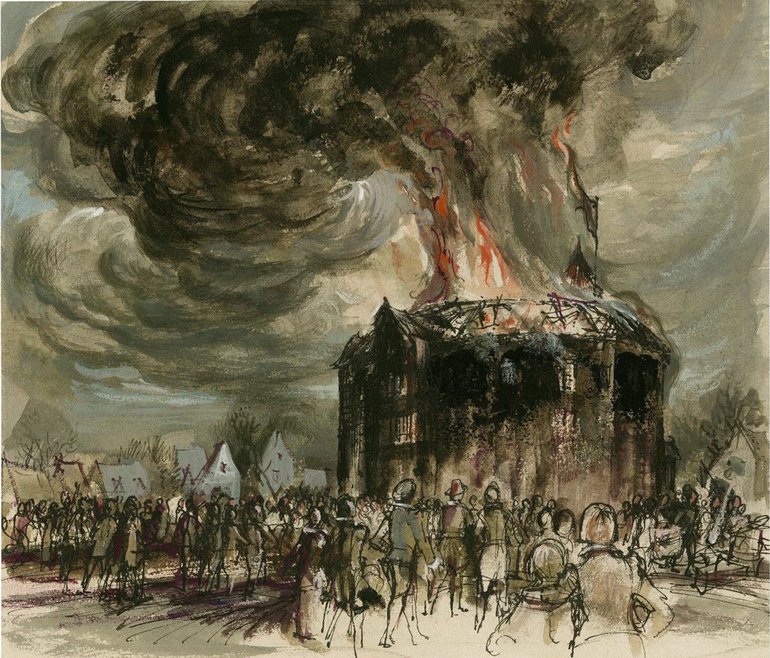Shakespeare's Globe Theatre
Third time's a charm: the when, how, and why behind Shakespeare's Globe Theatre
Building the First Globe Theatre
The story of the Globe Theatre starts with William Shakespeare's acting company The Lord Chamberlain's Men. Shakespeare was a part-owner, or sharer, in the company, as well as an actor and the resident playwright. From its inception in 1594, the Lord Chamberlain's Men performed at The Theatre, a playhouse located in Shoreditch. However, by 1598 their patrons, including the Earl of Southampton, had fallen out of favour with the Queen. The Theatre's landlord, Giles Alleyn, had intentions to cancel the company's lease and tear the building down.
While Alleyn did own the land, he did not own the materials with which The Theatre had been built. So, on 28 December 1598, after leasing a new site in Southwark, Cuthbert and Richard Burbage led the rest of the company of actors, sharers, and volunteers in taking the building down timber by timber, loading it on to barges, and making their way across the Thames. Working together, the actors built the new theatre as quickly as they could.

The ground on the new site was marshy and prone to flooding, but foundations were built by digging trenches, filling them with limestone, constructing brick walls above the stone, and then raising wooden beams on top of that. A funnel caught the rainwater and drained it into the ditch surrounding the theatre and down into the Thames.
The theatre was 30 metres in diameter and had 20 sides, giving it its perceived circular shape. The structure was similar to that of their old theatre, as well as that of the neighbouring bear garden. The rectangular stage, at five feet high, projected halfway into the yard and the circular galleries. The pillars were painted to look like Italian marble, the sky painted midnight blue, and images of the gods overlooked the balcony. It could hold up to 3,000 people.
By May 1599, the new theatre was ready to be opened. Burbage named it the Globe after the figure of Hercules carrying the globe on his back - for in like manner the actors carried the Globe's framework on their backs across the Thames. A flag of Hercules with the globe was raised above the theatre with the Latin motto 'totus mundus agit histrionem', or 'all the world's a playhouse'.
Shakespeare's plays that were performed there early on included: Henry V, Julius Caesar, As You Like It, Hamlet, Measure for Measure, Othello, King Lear, Macbeth, and Antony and Cleopatra. Here the Lord Chamberlain's Men enjoyed much success and gained the patronage of King James I in 1603, subsequently becoming The King's Men.

Disaster at the Globe
During the fateful performance of Henry VIII on 29 June 1613, the cannon announcing the unexpected arrival of the king at the end of Act 1 set fire to the thatched roof, and within an hour the Globe burned to the ground. Everyone escaped safely, save for one man whose breeches reportedly caught fire. Two different songs had been written about it by the next day.
The Globe was rebuilt by February 1614; the company could then afford to decorate it much more extravagantly, and it had a tiled roof instead of thatched. However, by this point Shakespeare's influence had lessened, and he was spending more and more time back in Stratford-upon-Avon.
Disaster struck again in the 1642 when parliament ordered the closure of London theatres. In 1644-5 the Globe was destroyed and the land sold for building.

Shakespeare's Globe Today
In 1970, an American actor and director Samuel Wanamaker set up the Shakespeare's Globe Trust to pursue his dream of reconstructing the original Globe Theatre. For what would be almost the next 30 years, he and his team worked and fought to obtain the permissions, funds, and research necessary for a project of this scope.
Historians, scholars, and architects all worked together in their efforts to build the Globe in the same way the Lord Chamberlain's Men did, down to the green oak pillars and thatched roof. Their work and dreams were fulfilled when the new Globe Theatre opened in 1997, one street away from where the original stood. The Globe stands today as a living monument to Shakespeare, the greatest English playwright, home to productions of his plays and many other new ones every season.
Help keep Shakespeare's story alive
Donate Online
Help keep Shakespeare's story alive
More like this
Shakespedia Index
More like this
Go behind the scenes
Read our blogs
Go behind the scenes
